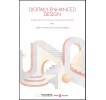Digitally enhanced design. Breakthrough tools, processes, and expressive potentials
Synopsis
Released under the Creative Commons License Attribution-NonCommercial-NoDerivatives 4.0 International (CC BY-NC-ND 4.0) in the peer reviewed series Design International.
The book explores evolving perspectives on furniture, interior, spatial and architectural design, providing a multifaceted view of how the design discipline and practice deal with the complex and ever-evolving interplay between the physical and the digital realms. It explores the new frontiers of digitally enhanced design, investigating how computation capabilities impact the design discipline and designers’ thinking and practice. Today more than ever, the design discipline must cope with the need to absorb technical skills and dialogue with traditionally distant domains. The core competencies in the Human Computer Interaction field are becoming essential to every design branch: the computational power is entering the design process, modifying how products and spaces are designed, how they are produced, and how they will impact the daily life of users.
The book explores these novel frontiers, proposing captivating portraits of digitally enhanced design possibilities, from tools and processes to expressive potentials.
Industry 4.0 and traditional craftsmanship hybridize in view of a circular and just economy for the furniture sector, imagining new approaches towards the European Green Deal. The sensing capabilities are intertwined with the materials to create a new form of animated objects, proposing a novel design approach beyond the user-centered one. The computational power of lighting design tools is entering the complex BIM methodology, exploring the problematic integration between the two worlds, and proposing solutions to support the design activity. Artificial Intelligence reframes the domestic landscape, thanks to Science Fiction Scenarios, to stimulate reflection on the designer’s role in framing utopic/dystopic futures. Finally, data drive the design of adaptive morphologies, exploring the context of computational design with a conceptual framework and reflecting on how robotic design can contribute to architecture.
Downloads


